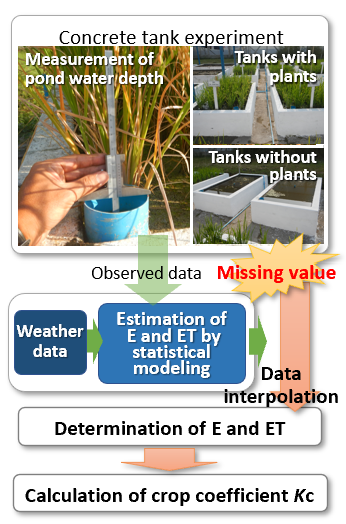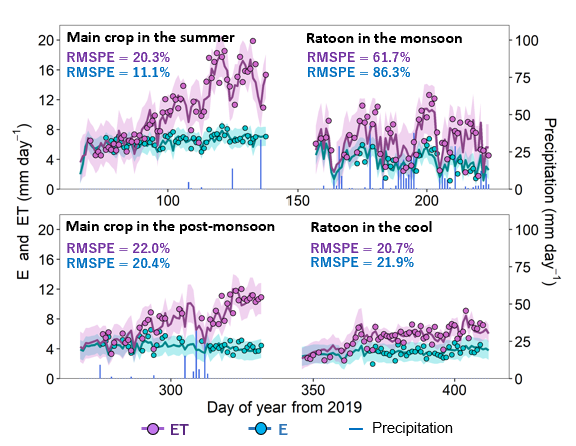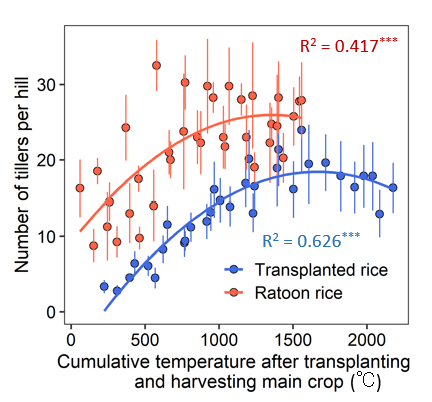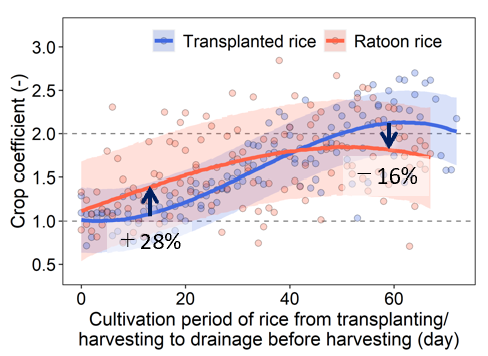Water requirement of ratoon rice is larger in the early growth stage and smaller in the late growth stage compared to transplanted rice
Description
Actual crop evapotranspiration (ET) and crop coefficients (Kc values) are necessary for ratoon rice crop irrigation planning, but these data have been hardly reported. Kc is usually determined experimentally, using ET values measured by lysimeters and eddy covariance. However, especially in developing countries, determining Kc remains difficult because ET observation systems are expensive. The focus of this study, therefore, was to evaluate the ET and Kc of ratoon cropping in a tropical region of Myanmar using a simplified method.Our method combined the manual observation of water depth in concrete paddy tanks (1.62 m L × 0.84 m W × 0.4 m D on the inside of tank) and the ET model estimation using Bayesian parameter inference with meteorological data. The difference in daily pond water depth (mm day–1) above the soil surface in a tank with and without planting rice are defined as daily ET and evaporation (E), respectively. When it rains, the daily pond water depth cannot be measured because the water balance in the tank is unknown. The missing ET and E values could be interpolated with modeled values by statistical modeling to determine the Kc values (Fig. 1).
The ratios of ET and E of ratoon crop to main crop (59% and 55% for the rainy season and 74% and 82% for the cool and dry season) were almost equivalent for both seasons (Fig. 2). Thus, the difference in the ET between main crop and ratoon was mainly attributed to the difference in climate conditions in each cropping period. The R2 of the transplanted rice was higher than that of the ratoon in number of tillers with the accumulated temperature. The transplanted rice reached the maximum tillering period at about 1,500°C accumulated temperature. On the other hand, the ratoon had vigorous tillering with large variations in the initial growth stage (Fig. 3). Consequently, the Kc regression curves for transplanted rice and ratoon crops were considerably different because of the difference in tillering traits (Fig. 4). The results suggest that irrigation scheduling of ratoon rice cropping should take into account higher crop water requirements in the initial growth stage and less water consumption in the late growth stage than transplanted rice cropping.
Figure, table
-
Fig. 1. Calculation procedure for crop coefficient Kc
Weather data indicate the net radiation, air temperature, humidity, and wind speed. -
Fig. 2. Observed and estimated E and ET in ratoon double rice cropping in different seasons
The periods of the first and second double cropping are February 2019 to August 2019 and September 2019 to April 2020, respectively. The model estimates are described with lines and bands corresponding to the means and 95% credible intervals. RMSPE, root mean squared percentage error. -
Fig. 3. Comparison of the cumulative temperature and number of tillers per hill described with non-linear bands and dots with bars
The error bars, the standard errors (n = 4₋8); R2, determination coefficient; ***, 0.001% significance level. -
Fig. 4. Kc regression curves for transplanted and ratoon rice described with lines and bands corresponding to the means and 95% credible intervals (transplanted rice: n = 138, ratoon: n = 135)
Values with percent in the figure is the increase-decrease rate in the Kc of ratoon rice with transplanted rice.Figures reprinted/modified with permission from Shiraki et al. (2021).
- Classification
-
Technical
- Research project
- Program name
- Term of research
-
FY 2019–2020
- Responsible researcher
-
Shiraki Shutaro ( Rural Development Division )
Thin Mar Cho ( Department of Agricultural Research, Myanmar )
- ほか
- Publication, etc.
-
Shiraki et al. (2021) Agronomy 11(8): 1573https://doi.org/10.3390/agronomy11081573
- Japanese PDF
-
2021_A02_ja.pdf600.12 KB
- English PDF
-
2021_A02_en.pdf459.44 KB
- Poster PDF
-
2021_A02_poster.pdf382.39 KB
* Affiliation at the time of implementation of the study.




